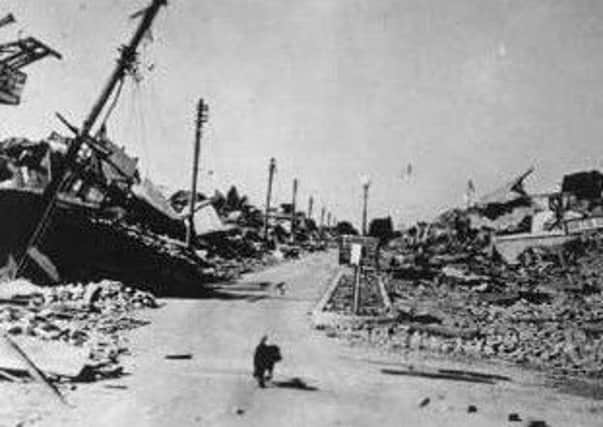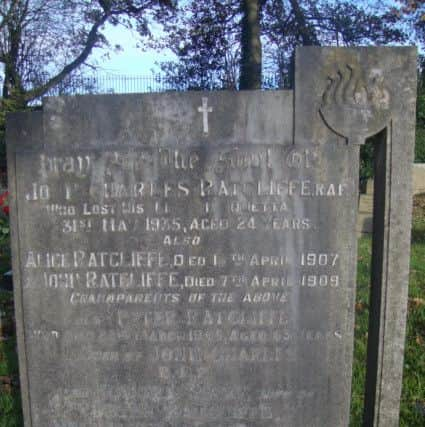Account of 1935 earthquake which killed Chorley aircraftsman


The magnitude of what is commonly referred to as the Quetta Earthquake was 7.7 Mw and it is estimated up to 60,000 people lost their lives.
Chorley man John Charles Ratcliffe was one of the casualties and was serving with the Royal Air Force at the time.
Advertisement
Hide AdAdvertisement
Hide AdAircraftsman John Ratcliffe 516547 was the son of Peter and Honora Mary Ratcliffe.


John, like all the bodies of the British dead, was buried in a communal grave in the churchyard at St Mary’s, Quetta, but the circumstance of his death is mentioned on his grandparents’ headstone in St Joseph’s Churchyard, Anderton.
As a member of the Armed Forces who lost his life while on active duty, John was also included on the Addenda panel of Adlington and District War Memorial.
Here is the Royal Air Force account of the incident:
The time at which the first shock of the earthquake occurred is given officially as 0306 hours on 31st May, 1935.


The night was fine but dark as there was no moon.
Advertisement
Hide AdAdvertisement
Hide AdThe main tremors of the Earth seem to have travelled from South to North, their Westward effect being limited, to a great extent in the Quetta Cantonment, by a deep Nullah, called the Duranni Nullah, running North to South through the Cantonment immediately East of the Fort.
Though many buildings West of this line were damaged none were wrecked in the way in which those on the East suffered.
The Royal Air Force lines comprising No. 3 (Indian) Wing, No. 5 (AC) Squadron and No. 31 (AC) Squadron were in the direct line of the Earthquake.
The Single Officers Quarters and some of the married quarters were situated about a mile and a half from the Airmen’s Barracks.
Advertisement
Hide AdAdvertisement
Hide AdOwing to the fact that they had comparatively small rooms they either withstood the shaking long enough to allow the occupants to escape before they collapsed, or else were only partially destroyed.
Thus although the majority of the occupants were partially buried or slightly injured, only one was so seriously hurt that he could not go to the assistance of the less fortunate families in the Lower quarters.
These bungalows, situated South of Quetta – Pishin Railway Line about 3/4 mile from the Airmen’s Barracks, all suffered very badly.
The inside walls and ceilings collapsed at the first shock jamming all the doors. The windows, which were usually kept open at night, were covered on the outside with strong extended steel netting to keep out thieves.
Advertisement
Hide AdAdvertisement
Hide AdThe greatest shock awaited the rescue party when it reached the airmen’s lines. What had once been the Airmen’s Barracks was now nothing but a series of detached heaps of brick rubble with the tin roofs torn and twisted on the top.
A few survivors were wandering among the ruins in a stunned condition, calling to trapped inmates. A few were desperately digging with their bare hands trying to release their buried friends.
In all, not more than 50 men were clear of the wreckage, most of these were injured.
The rescuers started work under three great handicaps, firstly there was no light, great clouds of dust, cut off what little help they could have hoped for from the stars, all electric light cables were down, dawn did not come until about 6.30am.
Advertisement
Hide AdAdvertisement
Hide AdSecondly, they had nothing to dig with except their hands and were mostly dressed only in pyjamas, few had shoes and nearly all had been cut, or bruised by broken glass and falling bricks.
Thirdly, their work was continually being undone, by fresh tremors, which occurred at frequent intervals during the first few hours, often reburying a victim who had just been on the point of release and forcing workers hurriedly to vacate the neighbourhood of any wall or roof.
As many of the men could only be reached by crawling under roof trusses or through holes torn in the corrugated iron sheeting, into positions from which rapid exit was impossible, rescue work was very dangerous and the courage with which men who had only just been dug out returned, in pitch darkness, into these dangerous positions was beyond praise.
Immediately before dawn a battalion of the Punjabis, who had been on a night march, came to our assistance and, as they brought with them their trenching tools, were of immense value and greatly speeded up the rescue work.
Advertisement
Hide AdAdvertisement
Hide AdAt about 8am a section of light tanks arrived and were at once set to work pulling the heavy roofs off the ruins.
The last survivor was extracted at noon. The last body removed at about 4pm.
A bull terrier was found alive and uninjured 36 hours after the disaster when search was being made for kit and personal belongings.
It was found that many of the victims died from suffocation.
Advertisement
Hide AdAdvertisement
Hide AdThe ceilings of the bungalows were made of mutty nearly one foot thick held in position by wire netting. This caused a great cloud of dust among the ruins and many of the men, who were under Mosquito nets, were unable to breathe owing to the dust and tightness of the nets over their faces.
The wire netting and mosquito nets also hampered the rescue workers who, having no cutting instruments, had to tear them away by main force.
The aircraft hangars of steel construction stood up to the earthquake, though most of the brick walled flight offices fell in or were damaged. Such was the violence of the shaking, however, that all the aircraft had been thrown about inside and dashed against each other or into the walls.
Inspection showed that only three out of the 27 held by the wing were fit to fly.
The total Royal Air Force dead were one officer, and 53 ‘British Other Ranks’.